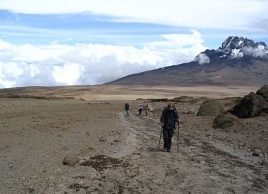Climbing Kilimanjaro
How a dozen women climbed Kilimanjaro and found true friendship

Source: Best Health Magazine, October 2008
Julie Regan can’t catch her breath. She takes two or three steps, then stops and vomits. Two or three steps more; stop, vomit. After an hour, there’s nothing left of the dinner she has eaten earlier that evening, but she continues to dry heave in the same pattern. She has to be careful all the while; a misstep off the trail could send her falling to her death.
Regan is about 16,000 feet (4,877 metres) up, struggling to reach the summit of Mount Kilimanjaro in Tanzania. It’s 1 a.m., pitch dark, and she has been ambushed by altitude sickness. As she climbs, she thinks back to the leaky dinner tent where earlier that night each of the dozen women realized that their greatest aspiration was to reach the summit together. That’s what keeps her feet moving.
Regan is the youngest of the women, who range in age from 39 to 50. Most are from Ontario, and most are novice mountain climbers. Almost all are at Kilimanjaro on this January day in 2008 for the same reason: a desire for adventure and a way to shake up their lives.
That’s how it started, at least, before they decided to harness all that energy for a cause: the Amani Children’s Home, which provides shelter and schooling for Tanzanian street kids and orphans. Alison Wiley, who spearheaded the climb, is president of Friends of Amani Canada. The climbers raised $80,000 for the home through donations from friends and corporations. Now they have to reach the top.
Not all those who attempt Kilimanjaro make it; younger, fitter people than these women have even died along the way. Many of the group—which included stay-at-home moms like Regan as well as doctors, lawyers, writers and entrepreneurs, with fitness levels that ranged from not working out at all to competitive athletes—met each other for the first time at Toronto’s Pearson airport only days before the climb. But the daily six- to eight-hour hikes up Kilimanjaro’s Machame Route, the endless conversations and the group pees quickly made them the closest of friends.
The women say their camaraderie pulled them through the toughest times, but they have trouble describing the phenomenon of their fast friendship. “We were, more or less, all driven by the same motivation,” says Jane Gill, a mother of two boys, 11 and 12. “In any other circumstance, there’d be a slow buildup of friendship. But there was no privacy there. You got to know people quickly.”
Gill, along with friend Martha Reeve, had originally been planning to go on a spa trip. Then Reeve, who runs regularly, called her and said, “I have a crazy idea. Why don’t we climb Mount Kilimanjaro?” It took Gill a couple of months to decide. Until then her fitness routine had consisted of chasing her kids up and down three flights of stairs. She was terrified she wouldn’t be physically fit enough to do it. “But it was that fear that got me working out,” Gill says.
Mount Kilimanjaro is known as “Everyman’s Everest.” You don’t need mountain-climbing skills, but you do need the endurance and strength to hike up steep inclines eight hours a day for five days, and the willingness to rough it, all the while withstanding low oxygen levels and whatever elements Mother Nature decides to throw at you.
The weather is perfect at first, but by the third day the torrential rain starts, and it turns into snow and sleet that doesn’t stop for the rest of the climb up. They sleep in their damp clothes, which dry with their body heat.
At any one time, three or four different conversations are going on, running the gamut from how they met their mates to launching new businesses. Jane Rosmus says that through this sharing, she felt she got back to the person she used to be. “With all the running around of daily life, I always had a feeling I was losing a little of myself—the person I was back in high school and university.”
On day four, dinner is at 5 p.m. They go to bed at 7 p.m. and wake again at 11 p.m. to pack up camp. The climb starts at midnight. An hour later, Regan’s fellow climbers have pulled ahead of her as she struggles with altitude sickness. Her mates are just dark, distant silhouettes against the black horizon. The bobbing lights of their headlamps reflect off the snow, making it glow blue-grey. She is athletic; she mountain bikes and skis. Ironically, she used to run a company that offered helicopter and bike tours of Whistler, B.C. But here, the thin air is not only frustrating, it feels like it’s almost killing her.
Then her guide starts singing in Swahili. It’s the hymn “Angels We Have Heard on High.” “It was mind-blowing,” says Regan. “I’m hearing this behind me, and it’s pushing me up the hill.”
As she reaches the summit at about 10 a.m., where her newfound friends have been waiting for half an hour, she hears a cheer as they rush to meet her. As Rosmus, who invited her on the trip, hugs her friend, she says to Regan, “I kept telling them you’ll make it if it kills you.”
Today, the women are thinking of climbing another mountain, once again to help a charity. “Combining the personal challenge with something really meaningful made for an enriching experience,” says Wiley. “You realize you can make a difference in this world.”
Erin Hogan, another member of the group, tries to explain their bond. “When someone faltered, we helped them. When someone didn’t have the equipment, everyone offered what they could. We weren’t cliques. To me, that’s how the world should be."
Found this article informative? Subscribe to our magazine today and receive more Best Health exclusives delivered to your door!




